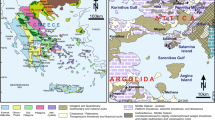Abstract.
The time scales of magma formation, transfer and storage beneath island arc volcanoes are important because of the insights they provide into the physical processes of magma formation and evolution with possible links to the prediction of eruptive hazards. Here we present new mass spectrometric U, Th and Ra, and Sr, Nd and Pb isotope data, along with major and trace element data, from 19 lavas along the Sunda arc, Indonesia. The lavas range in SiO2 from 49 to 75% and the combination of high SiO2 and low 143Nd/144Nd indicates an important role for shallow-level contamination by ancient crustal materials in Sumatra. Diagrams of 143Nd/144Nd versus Th/Ce and U/Th versus 87Sr/86Sr reveal negative trends which allow contributions from both subducted sediments and fluids to be identified. The fluid component as expressed in elevated U/Th, (238U/230Th) and (226Ra/230Th)o ratios is ubiquitous in all of the lavas including near primary lavas from Galunggung. Sr isotope data indicate that the fluids had variable composition and derived from altered oceanic crust, and the U, Th and Ra isotope data suggest that some fluid components must have been added less than 8,000 years ago. Tholeiitic lavas from Flores have the lowest Th contents in the arc and accordingly the highest (226Ra/230Th)o and (238U/230Th). For these there is evidence that both U and Ra addition probably occurred less than a few thousand years ago. This suggests that the onset of melting was linked to fluid fluxing and cannot have been due to decompression alone. In contrast, the sediment component may have been added as a partial melt and sediment addition can account for the observed along-arc variations in Sr, Nd, Pb and Th isotopes. There is no requirement in our data for an OIB component in the mantle wedge. Increases in SiO2 in the Galunggung lavas are accompanied by decreases in both (238U/230Th) and (226Ra/230Th)o, which are inferred to reflect mixing with melts of pre-existing mafic lavas. Mixing and differentiation must have occurred faster than could be recorded by either the 238U–230Th or 226Ra–230Th systems. There is little evidence in our data for any effect of the Australia–Indonesia collision on the composition of the lavas. Across-arc trends in lava composition indicate an increasing relative contribution from subducted sediment, a correspondingly weaker fluid signal and probable decreases in the degree of partial melting. Residual aluminous clinopyroxene or garnet may become important in controlling REE and U/Th fractionation in the far back-arc.
Similar content being viewed by others
Author information
Authors and Affiliations
Rights and permissions
About this article
Cite this article
Turner, S., Foden, J. U, Th and Ra disequilibria, Sr, Nd and Pb isotope and trace element variations in Sunda arc lavas: predominance of a subducted sediment component. Contrib Mineral Petrol 142, 43–57 (2001). https://doi.org/10.1007/s004100100271
Received:
Accepted:
Published:
Issue Date:
DOI: https://doi.org/10.1007/s004100100271




